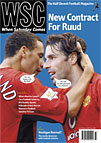 Coming to a ground near you – a broadsheet journalist who knows little about football and less about hooliganism, but is still writing about them, to Barnay Ronay's fury
Coming to a ground near you – a broadsheet journalist who knows little about football and less about hooliganism, but is still writing about them, to Barnay Ronay's fury
Football is in the grip of a new and terrifying menace: journalists writing articles about hooliganism. Not to mention low-budget British films about hooliganism, journalists writing articles about low-budget films about hooliganism – and now a new and even more sinister threat: football magazines publishing articles about newspaper stories about hooliganism.
On January 3 the Times ran an article headed When Saturday Comes (a reference, presumably, to Sean Bean’s unsavoury film of the same name), in which the terrifying activities of a “new breed” of hooligans are detailed. According to the Times, “otherwise respectable young professionals” are at the forefront of crews, firms and posses the length and breadth of the country.
On the back of statistics suggesting a rise in football violence, a Times reporter is dispatched to Cardiff in search of a little vicarious action. In “a packed and intimidating pub in Grangetown”, he finds to his considerable relief that the only two locals he can bring himself to talk to are “a secondary school teacher and an actor with a first-class degree in politics”, who are “sipping cokes and talking quietly”. But in fact, “at football matches their designer attire is a subtle badge of identity”. And fortunately for our reporter the lads have seen some fights and are only too happy to talk. Teacher tells of his inability to control his class until “somebody said I looked like a football casual. I ended up coming out with a brief history of the Soul Crew, mentioning a few incidents I’d witnessed. Within minutes the class was hanging on my every word. Even the girls!”
In the long tradition of articles about hooligans we find, yet again, the classic first position: ask any man in a pub whether he’s actually the highly organised charismatic general of a devoted paramilitary army; or involved in an ID magazine-style youth sub-culture of 1980s casual/hooligan revivalist fashion, and the chances are he’ll say “yes”. Even if he’s really a teacher. Tellingly, one of our thugs concludes breathlessly: “I’m seeing more of life than a graduate straight out of drama school.” Take that, Chelsea Headhunters!
The article goes on to describe, in hushed tones, a group of men standing around (“200 Soul Crew have mobbed on the pavement… most have adopted a casual look”). Nothing happens for a bit until, “with no discernible call to arms”, everybody starts to walk off. There’s some chanting (“Blue Army!”). The police block the road for a bit, which happens fairly often at football matches, demonstrations or even in the rush hour. Hold on, what’s this? A fight has broken out. But wait! It’s the man from the Times! “The Times photographer is dragged from his perch on a nearby wall by a man screaming, ‘Who the f*** are ya?’”
And that’s about it, apart from “both gangs taunting each other” during the game, ie singing songs. In a postscript we find ourselves in a pub with four young men “whose occupations range from telecommunications project manager to postgraduate student”, who are also happy to tell the Times that, yes, they are at the apex of some kind of hardman/street fashion youth phenomenon. “I ask if they feel part of the new casual generation. ‘Too right,’ they reply.” But disappointingly, “it’s about football, fashion and music” and even our reporter admits that they are in fact “fairly ordinary working-class men”. The exposé ends with something of a whimper: “It [going to football matches] is our chance to show how confident we are, how well we dress, how loud we sing. It’s a civic pride thing.”
The Times’ Soul Crew are a precursor to the film of the same name currently in production, an adaptation of Soul Crew the book, written by a pair of former Cardiff hooligans. Hilariously, actor Lewis Owen, one of the stars, has been reprimanded after being spotted by police mixing with known hooligans at games. Meanwhile, The Football Factory, due for release later this year, promises similar tales of urban male alienation, edgy 1980s designer labels and plenty of extras called Jeremy pretending to kneecap one another.
Hooligans (1980s-2003 vintage), bandwagon-jumping newspaper editors and makers of poor sound-quality British films will always attach themselves to football. And violence. And anything else that gives rein to the imagination. The Times magazine piece, essentially a story without a story, is another symptom of the game becoming an everyday subject for the chattering media. Hooligans aren’t “young professionals” or 1980s fashionistas. They’re drunken mob-brained men throwing chairs around in a European square. They’re still with us and probably right this moment mapping out their Portuguese holidays. Where a man from the Times may well choose exactly the wrong moment to ask them what kind of music they like and if that’s a Prada jacket they’re wearing.
From WSC 205 March 2004. What was happening this month